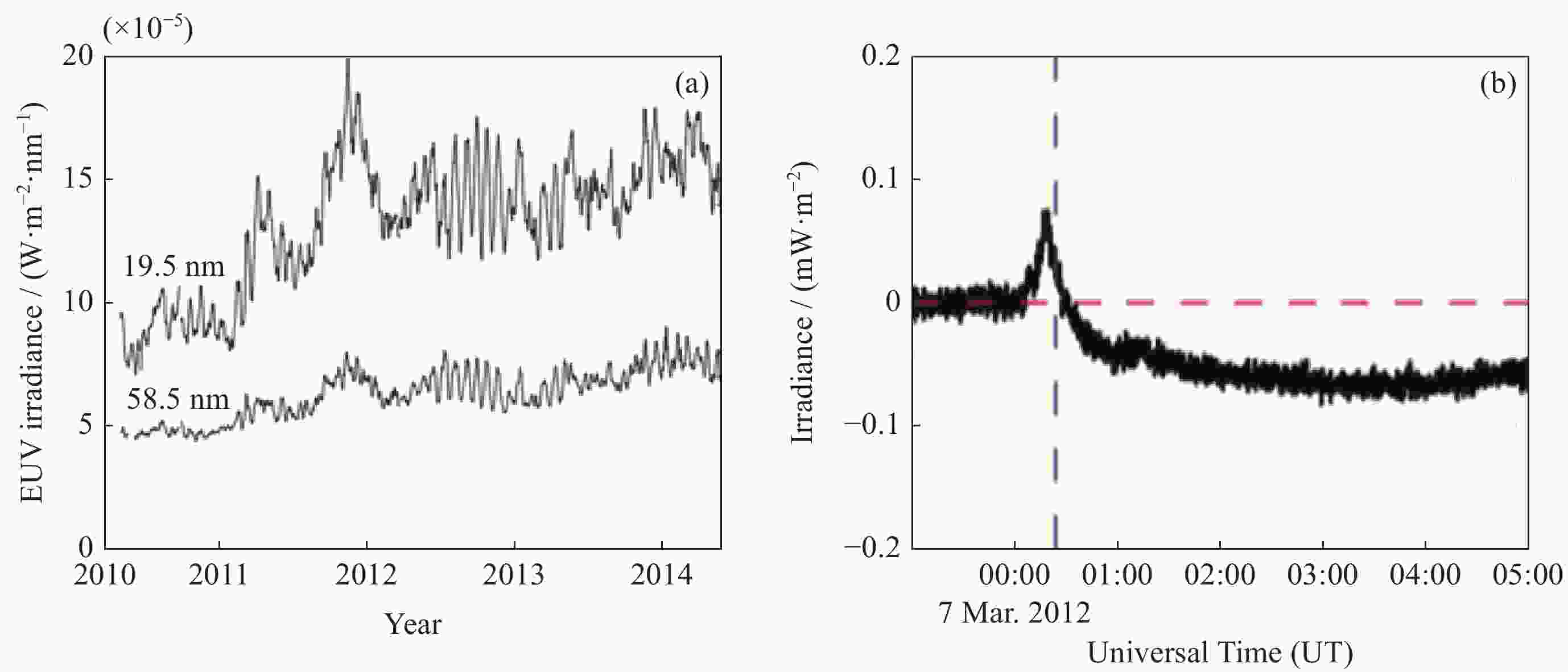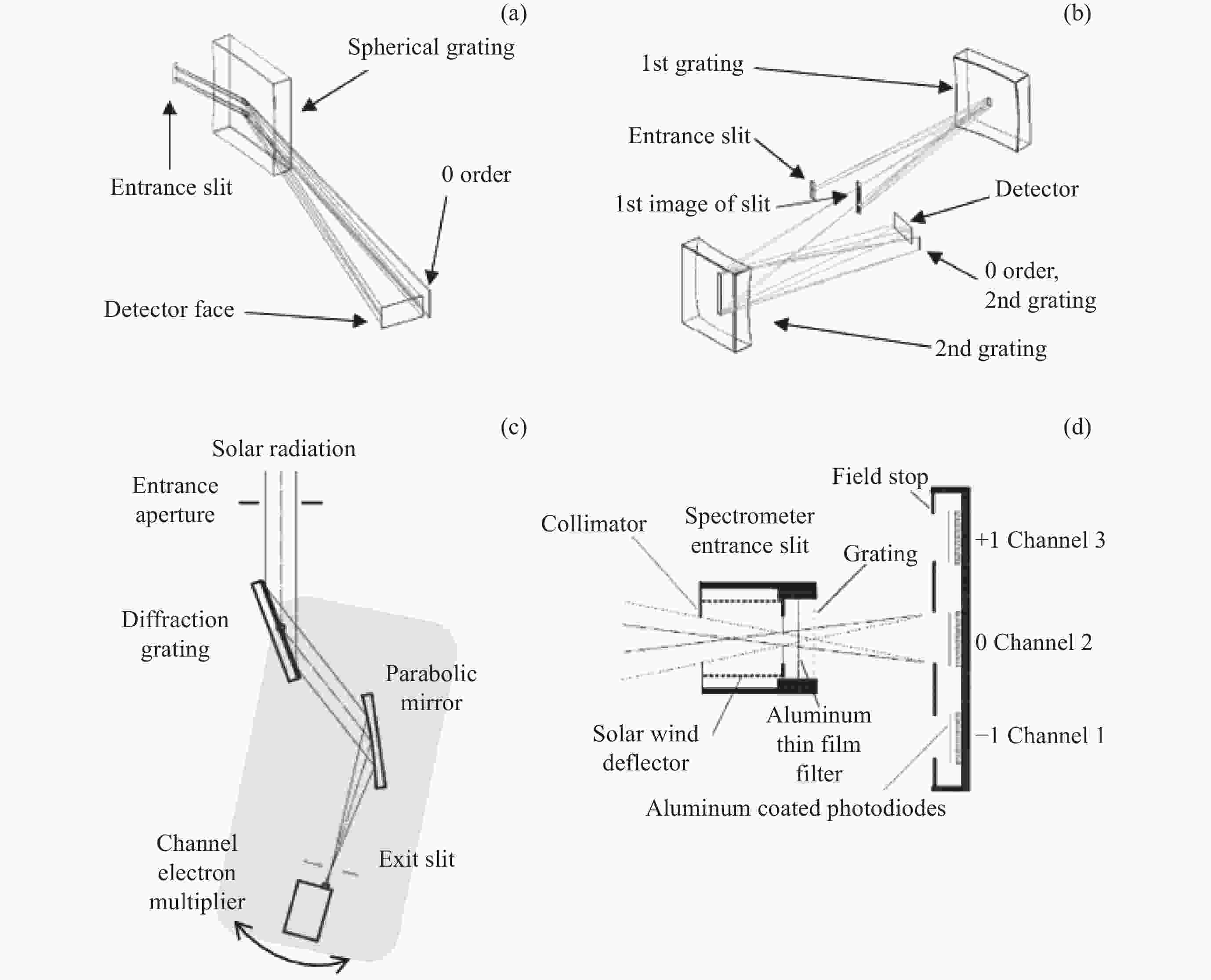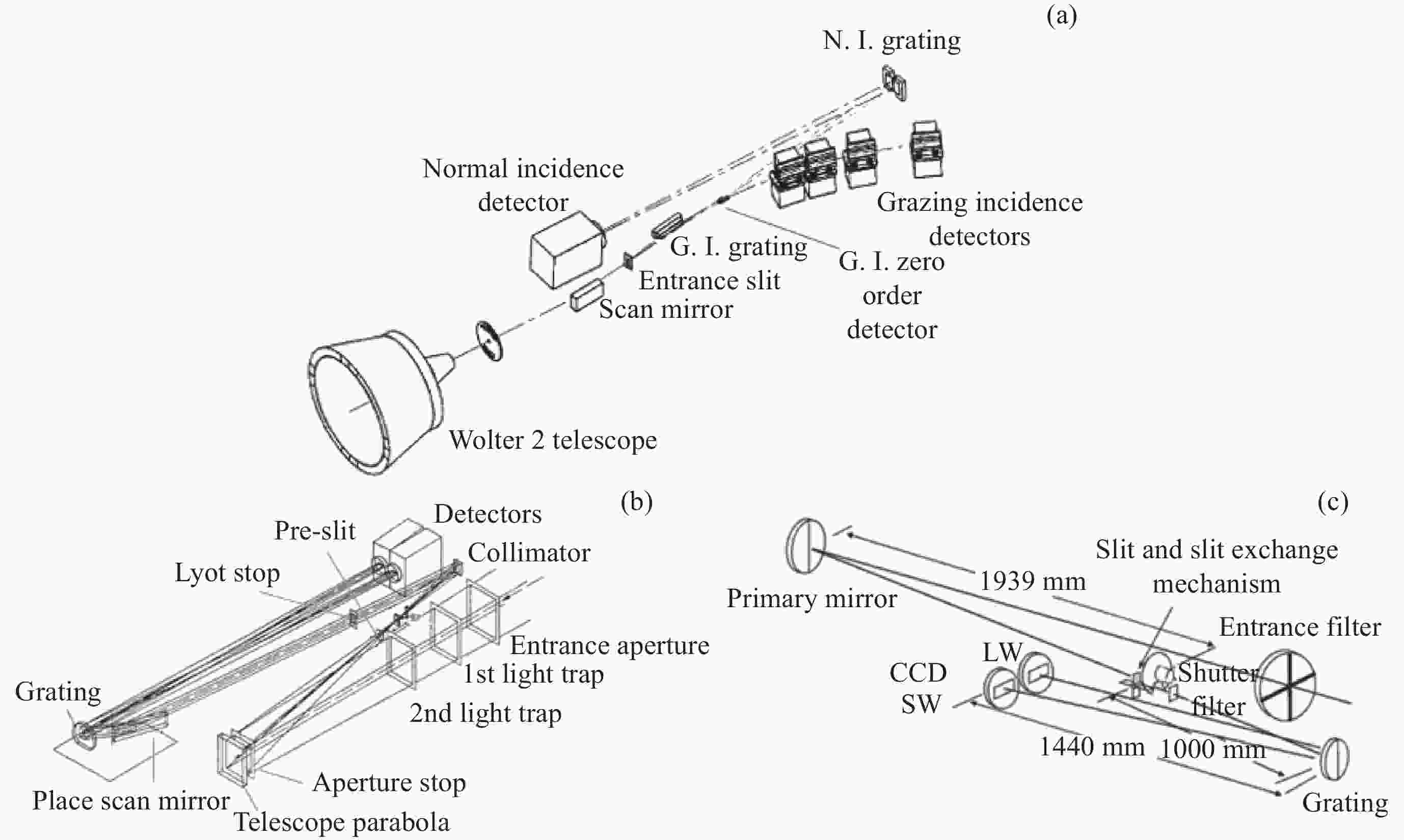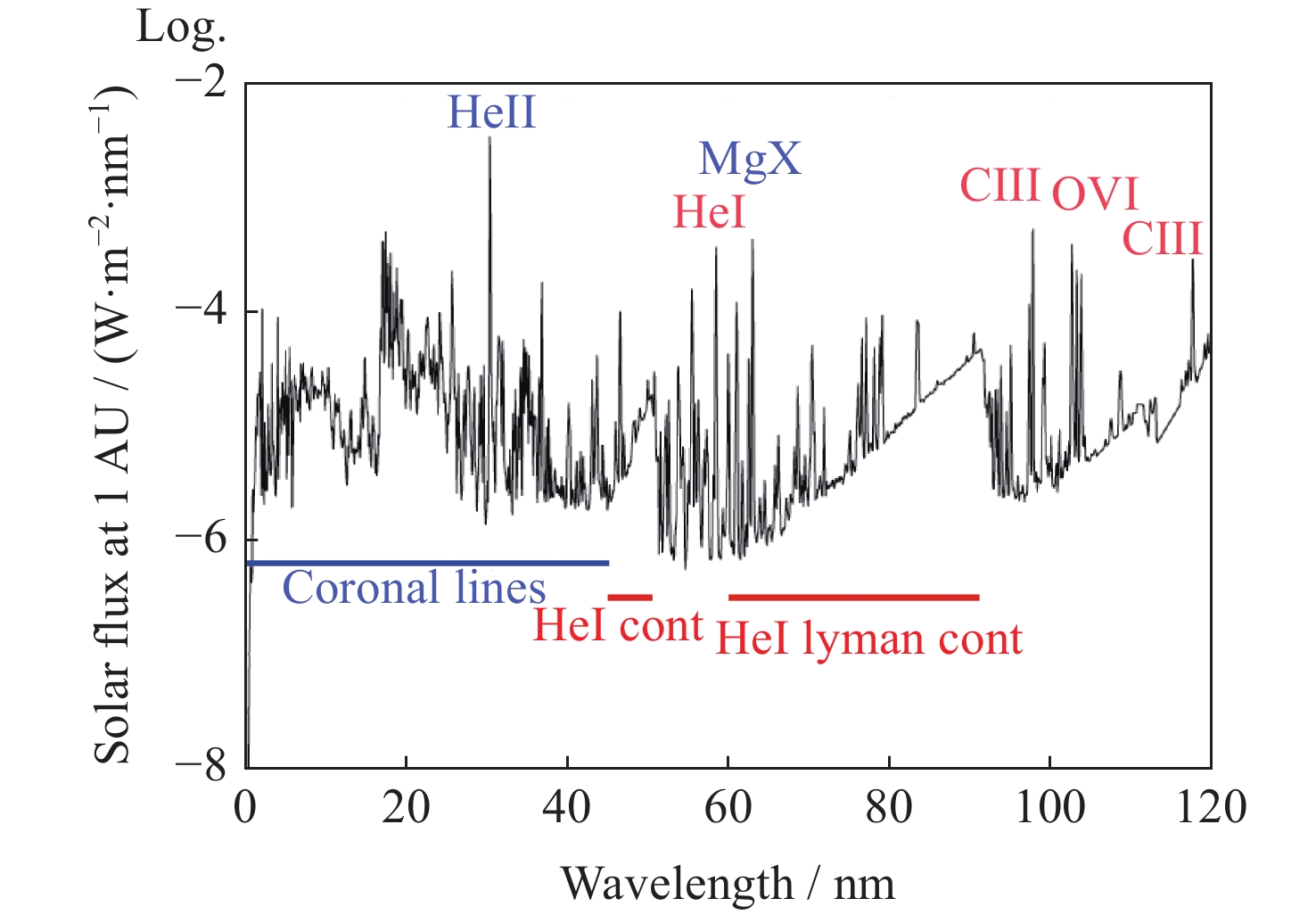Current Status and Future Perspectives of Solar Spectroscopic Observations at Extreme Ultraviolet Wavelengths
-
摘要: 围绕国际一流科学目标,发展顶级探测设备是中国太阳物理位列国际先进行列的立足点。70多年的空间太阳探测历程中,极紫外波段探测发挥了极其重要的作用,极紫外观测设备也几乎成为了太阳探测卫星的必备载荷之一。中国在极紫外探测,尤其是光谱探测方面的基础非常薄弱,导致相关科学研究几乎全部依赖国外数据,从而严重制约了中国太阳物理学科的发展。本文根据太阳极紫外探测的特点,系统分析了国外光谱探测的历史、现状以及未来发展趋势,并归纳了三类主要探测方式,即全日面积分光谱探测、低速光谱成像探测、快速光谱成像探测的当前水平,包括其技术方案及取得的部分科学成果。在此基础上,提出中国太阳极紫外光谱探测“三步走”的发展思路,并对每一步的科学目标、指标需求和候选探测方案提出建议。同时,展望了在太阳极紫外成像探测方面开展创新性尝试的思路。Abstract: More than 70 years of the space-borne solar exploration clearly shows that Extreme Ultraviolet (EUV) wavelengths are very useful for observations of the solar transition region and corona. Because of this, almost all of the current and future solar space missions have EUV payloads. Unfortunately, China has never sent a solar EUV spectrometer to space so far, which significantly restricts the chance for Chinese solar physicists to have original discoveries and breakthroughs. Now it is the right time to develop our own payloads and contribute to space exploration of solar physics. In the paper, the characteristics of solar irradiance as well as the common optical elements at EUV wavelengths are introduced firstly. The history, current status and future perspectives of solar EUV spectroscopic observations are systematically reviewed, including the instrument designs and major scientific achievements. Three major types of spectroscopic observations are focused on, i.e., full-disk integrated irradiance measurements, low-speed spectroscopic imaging observations with a certain spatial resolution and two-dimensional fast spectroscopic imaging. Then, a three-step development strategy is proposed to start Chinese solar EUV spectroscopic observations in space. The scientific objectives, observational requirements and candidate schemes of each step are discussed. Moreover, a solar EUV imager working at a wavelength that has never been done before is suggested. Once the above explorations are successfully implemented, major advances towards our understanding of many unsolved solar mysteries will be made, including the accurate speed estimation of coronal mass ejections and forecast of their arrival times at the Earth, the origin of solar wind and coronal heating mechanism, as well as the generation mechanism of solar eruptions. It will significantly elevate the level of key technologies involved in ultraviolet space explorations, too.
-
Key words:
- Sun /
- Solar corona /
- Extreme Ultraviolet /
- Space exploration /
- Spectrograph
-
图 2 (a) 30 nm厚的镀金单层膜反射镜在入射角3°(正入射,绿色)和87°(掠入射,蓝色)时对极紫外辐射的反射率;(b)不同材料多层膜在极紫外波段的反射率
Figure 2. (a) Reflectance of the Au coated mirror with a thickness of 30 nm at the incident angle of 3 (normal incidence, green curve) and 87 degrees (grazing incidence, blue curve) at EUV wavelengths. (b) Reflectance of the EUV multilayer mirrors with various materials
图 3 (a) SDO/EVE观测的Fe XII 19.5 nm和He I 58.5 nm太阳辐射在2010-2014年的变化。(b) SDO/EVE观测的全日面积分Fe IX 17.1 nm辐射在6 h内的变化,蓝色虚线处辐射增强对应太阳耀斑,红色虚线代表宁静背景辐射,耀斑后辐射相比宁静背景辐射的减弱即为日冕物质抛射导致的日冕暗化
Figure 3. (a) Evolution of solar EUV irradiance observed by SDO/EVE from 2010 to 2014 at the wavelengths of Fe XII 19.5 and He I 58.5 nm. (b) Evolution of solar EUV irradiance for Fe IX 17.1 nm within six hours. Radiance enhancement indicated by the blue dashed line corresponds to the solar flare while the red dashed line represents the background radiation of quiet sun. The radiance weakening relative to the background radiation is the corona dimming induced by the coronal mass ejection
图 4 全日面积分光谱探测采用的4种光学系统。(a)掠入射单凹面光栅,(b)交叉色散正入射凹面光栅,(c)掠入射平面光栅+聚焦镜,(d)透射式光栅
Figure 4. Four types of optical layouts used for solar EUV irradiance measurements. (a) Single concave grating for grazing incidence. (b) Cross-dispersed double-Rowland circle grating for normal incidence. (c) Grazing incidence planar grating with the parabolic mirror. (d) Transmission grating
图 6 (a)无缝光谱成像观测系统。(b)焦面谱像耦合示意,圆圈代表日面大小,不同圆圈代表不同波长日面辐射位置,多个圆圈交叉代表存在谱像耦合,交叉越多代表谱像耦合越严重
Figure 6. (a) Slitless solar imaging spectroscopy. (b) Schematic diagram of focal plane spectral image coupling. Circles represent the solar image and different circles represent the one with diverse spectral lines. The smaller the distance between multiple circles, the more impact of spectral lines from neighboring solar positions
表 1 1960年至今主要的全日面积分极紫外光谱探测设备及其参数(仪器类型见图4a~d)
Table 1. Representative instruments for solar EUV irradiance measurements and their corresponding parameters since 1960 (Instrumental types are summarized in Fig.4a~d)
载荷 卫星 国家或地区 观测时间 设备类型 波长范围/nm 光谱分
辨率/nm时间分
辨率/min探测器 GIS OSO-1[16] 美国 1962 4(a) 1~40 0.17 / / GIS OSO-3[17] 美国 1967-1969 4(a) 2~40 约0.06 32 点源扫描光谱 GIS OSO-5[18] 美国 1969 4(a) 2.5~40 约0.03 约30 点源扫描光谱 EUVS Aeros A/B[19] 德国/美国 1972-1973
1974-19754(c) 16~106 约1 / 点源扫描光谱 EUVS AE-C/E[20] 美国 1973-1974
1976-19814(c) 14~185 约0.3 / 点源扫描光谱 SUSIM UARS[21] 美国 1991-2005 / 115~410 约1 / / SOLSTICE SORCE[22] 美国 2003-现在 / 125~320 约7 10 / SEE TIMED[23] 美国 2002-现在 4(b) 27~194 约0.4 每天1次 64×1024位敏阳极 SUFR CORONAS-F[24,25] 俄罗斯 2001 / 1~130 约12 7 / SEM SOHO[26] 美国 1995-现在 4(d) 25~34 5 1 点源 ACE ISS[27] 欧洲 2008-现在 4(c) 16~220 0.5~2.3 每天1次 点源扫描 EUVS GOES-R[28] 美国 2016-现在 4(a) 25~32
117~1410.6 3 线阵 EVE-MEGS SDO[29] 美国 2010-现在 4(a)/4(b) 5~121 0.1 10 面阵CCD EVE-ESP SDO[30] 美国 2010-现在 4(d) 18~37 4 0.25 线阵 注 符号“ / ” 表示不属于这类设备或查不到具体指标。 表 2 过去50年主要的太阳极紫外光谱成像探测设备
Table 2. Representative solar EUV imaging spectrometers used in the past fifty years
设备 国家或
地区年代 空间分辨
率/(″ )观测波
段/nm光谱分
辨率/nm成像方式 光栅类型 探测器类型 OSO-4/6/7[36] 美国 1967 差于60 15~140 约 0.3 掠入射,点源光谱 罗兰圆 点源/扫描光谱 Skylab-SO82A[37] 美国 1973 差于5 17~63 ≥0.003(存在
谱像耦合)正入射无缝光谱 球面固定线距 胶片 SOHO/SUMER[38] 欧洲 1995 约3 50~161 约0.0042,80 正入射,狭缝光谱 球面固定线距 像增强器 SOHO/CDS[39] 欧洲 1995 约6 15~78 约0.021 掠入射,点源光谱 球面固定线距 像增强器 HINODE/EIS[40] 日美英 2006 约3 17~21 25~29 约0.006,26 正入射,狭缝光谱 超环面固定线距 背照式CCD SO/SPICE[41] 欧洲 2020 约4 70~79 97~104 约0.026,74 正入射,狭缝光谱 超环面变线距 像增强器 表 3 中国未来太阳极紫外光谱探测设备及其指标需求建议
Table 3. Suggestion on the future solar EUV spectrographs and their observational requirements in China
探测阶段 探测名称 工作谱线/波段/nm 视场/(′ ) 空间分
辨率/(″ )狭缝数量 光谱分辨
本领 (λ/Δλ)时间分辨率/s 第一步 高光谱分辨率全日面积分极紫外光谱仪 18~27 ≥$\phi $33 - 1 ≥500 约60 第二步 高空间分辨率狭缝光谱仪 17~21/25~29 33~36/42~47 >0.0042×3 约0.5 1 ≥4000 约30 高空间分辨率成像仪 Fe XII 19.5/Fe IX 17.1/ Ne VII 46.5 约3×3 约0.2 0 ≤1 nm
@19.5/17.1 nm
≤3 nm
@46.5 nm约10 第三步 全日面多缝快速扫描光谱仪 Fe XII 19.5 /Ne VII 46.5 /Ly-a 121.6/He II 30.4 (候选的重点谱线) 约42×42(单狭缝约0.67×42) 约6 ≥5 ≥3000 约240 -
[1] TOUSEY R. Solar spectroscopy from Rowland to SOT[J]. Vistas in Astronomy, 1986, 29: 175-199 doi: 10.1016/0083-6656(86)90007-3 [2] LINSKY J L, FONTENLA J, FRANCE K. The intrinsic extreme ultraviolet fluxes of F5 V to M5 V stars[J]. The Astrophysical Journal Letters, 2013, 780(1): 61 doi: 10.1088/0004-637X/780/1/61 [3] BROOKS D H, YARDLEY S L. The source of the major solar energetic particle events from super active region 11944[J]. Science Advances, 2021, 7(10): eabf0068 doi: 10.1126/sciadv.abf0068 [4] CHEN Y J, LI W X, TIAN H, et al. Forward modeling of solar coronal magnetic-field measurements based on a magnetic-field-induced transition in Fe X[J]. The Astrophysical Journal Letters, 2021, 920(2): 116 doi: 10.3847/1538-4357/ac1792 [5] LANDI E, HUTTON R, BRAGE T, et al. Hinode/EIS measurements of active-region magnetic fields[J]. The Astrophysical Journal Letters, 2020, 904(2): 87 doi: 10.3847/1538-4357/abbf54 [6] MASON J P, WOODS T N, WEBB D F, et al. Relationship of EUV irradiance coronal dimming slope and depth to coronal mass ejection speed and mass[J]. The Astrophysical Journal Letters, 2016, 830(1): 20 doi: 10.3847/0004-637X/830/1/20 [7] ASCHWANDEN M J, WUELSER J P, NITTA N V, et al. Solar flare and CME observations with STEREO/EUVI[J]. Solar Physics, 2009, 256(1): 3-40 [8] ZHANG J, TEMMER M, GOPALSWAMY N, et al. Earth-affecting solar transients: A review of progresses in solar cycle 24[J]. Progress in Earth and Planetary Science, 2021, 8(1): 1-102 doi: 10.1186/s40645-020-00388-2 [9] TORIUMI S, AIRAPETIAN V S, HUDSON H S, et al. Sun-as-a-star spectral irradiance observations of transiting active regions[J]. The Astrophysical Journal Letters, 2020, 902(1): 36 doi: 10.3847/1538-4357/abadf9 [10] LI C, FANG C, LI Z, et al. Chinese Hα Solar Explorer (CHASE) - a complementary space mission to the ASO-S[J]. Research in Astronomy and Astrophysics, 2019, 19(11): 165 doi: 10.1088/1674-4527/19/11/165 [11] GAN W Q, DING M D, HUANG Y, et al. Preface: Advanced space-based solar observatory (ASO-S)[J]. Research in Astronomy and Astrophysics, 2019, 19(11): 155 doi: 10.1088/1674-4527/19/11/155 [12] ZHANG P, HU X Q, LU Q F, et al. FY-3 E: The first operational meteorological satellite mission in an early morning orbit[J]. Advances in Atmospheric Sciences, 2022, 39(1): 1-8 doi: 10.1007/s00376-021-1304-7 [13] BAI X, TIAN H, DENG Y, et al. The solar upper transition region imager (SUTRI) onboard the SATech-01 satellite[EB/OL]. 2023: arXiv: 2303.03669. https://arxiv.org/abs/2303.03669 [14] WINDT D L. EUV multilayer coatings for solar imaging and spectroscopy[C]//SPIE Optical Engineering + Applications. California: SPIE, 2015, 9604: 161-172 [15] VOURLIDAS A, BRUINSMA S. EUV irradiance inputs to thermospheric density models: Open issues and path forward[J]. Space Weather, 2018, 16(1): 5-15 doi: 10.1002/2017SW001725 [16] BEHRING W E. A spectrometer for observations of the solar extreme ultraviolet from the OSO-I satellite[J]. Applied Optics, 1970, 9(5): 1006-1013 doi: 10.1364/AO.9.001006 [17] HINTEREGGER H E, HALL L A. Solar extreme ultraviolet emissions in the range 260-1300 Å observed from OSO-III[J]. Solar Physics, 1969, 6(2): 175-182 doi: 10.1007/BF00150942 [18] KASTNER S O, NEUPERT W M, SWARTZ M. Solar-flare emission lines in the range from 66 to 171 Å; transitions in highly ionized iron[J]. The Astrophysical Journal Letters, 1974, 191: 261 doi: 10.1086/152963 [19] SCHMIDTKE G, RAWER K, BOTZEK H, et al. Solar EUV photon fluxes measured aboard Aeros A[J]. Journal of Geophysical Research, 1977, 82(16): 2423-2427 doi: 10.1029/JA082i016p02423 [20] HINTEREGGER H E, BEDO D E, MANSON J E. The EUV spectrophotometer on atmosphere explorer[J]. Radio Science, 1973, 8(4): 349-359 doi: 10.1029/RS008i004p00349 [21] ROTTMAN G J, WOODS T N. Upper atmosphere research satellite (UARS) solar stellar irradiance comparison experiment (SOLSTICE)[C]//SPIE’s 1994 International Symposium on Optics, Imaging, and Instrumentation. San Diego: SPIE 1994, 2266: 317-327 [22] WOODS T N, ROTTMAN G, VEST R. XUV photometer system (XPS): Overview and calibrations[J]. Solar Physics, 2005, 230(1): 345-374 [23] WOODS T N, ROTTMAN G J, ROBLE R G, et al. Thermosphere-ionsphere-mesosphere energetics and dynamics (TIMED) solar EUV experiment[C]//SPIE’s 1994 International Symposium on Optics, Imaging, and Instrumentation. San Diego: SPIE, 1994, 2266: 467-478 [24] NUSINOV A A, KAZACHEVSKAYA T V, KATYUSHINA V V, et al. Measurement of extreme ultraviolet solar radiation in different wavelength intervals onboard the CORONAS satellites: Instruments and main results[J]. Solar System Research, 2005, 39(6): 470-478 doi: 10.1007/s11208-005-0060-z [25] AVAKYAN S V, BARANOVA L A, LEONOV N B, et al. Space Solar Patrol data and changes in weather and climate, including global warming[J]. Measurement Science and Technology, 2010, 21(8): 085301 doi: 10.1088/0957-0233/21/8/085301 [26] JUDGE D L, MCMULLIN D R, OGAWA H S, et al. First Solar EUV Irradiances Obtained from SOHO by the CELIAS/SEM[M]//Solar Electromagnetic Radiation Study for Solar Cycle 22. Dordrecht: Springer Netherlands, 1998: 161-173 [27] SCHMIDTKE G, BRUNNER R, EBERHARD D, et al. SOL-ACES: Auto-calibrating EUV/UV spectrometers for measurements onboard the international space station[J]. Advances in Space Research, 2006, 37(2): 273-282 doi: 10.1016/j.asr.2005.01.112 [28] EPARVIER F G, CROTSER D, JONES A R, et al. The extreme ultraviolet sensor (EUVS) for GOES-R[C]//SPIE Optical Engineering + Applications. San Diego, California: SPIE, 2009, 7438: 31-38 [29] WOODS T N, EPARVIER F G, HOCK R, et al. Extreme ultraviolet variability experiment (EVE) on the solar dynamics observatory (SDO): Overview of science objectives, instrument design, data products, and model developments[J]. Solar Physics, 2012, 275(1/2): 115-143 [30] DOMINIQUE M, HOCHEDEZ J F, SCHMUTZ W, et al. The LYRA instrument onboard PROBA2: Description and In-flight performance[J]. Solar Physics, 2013, 286(1): 21-42 doi: 10.1007/s11207-013-0252-5 [31] WANG H F, WANG X D, CHEN B, et al. EUV multilayer mirrors in solar X-EUV Imager[J]. Optik, 2020, 204: 164213 doi: 10.1016/j.ijleo.2020.164213 [32] MASON J P, WOODS T N, CASPI A, et al. Mechanisms and observations of coronal dimming for the 2010 August 7 event[J]. The Astrophysical Journal Letters, 2014, 789(1): 61 doi: 10.1088/0004-637X/789/1/61 [33] HARRA L K, SCHRIJVER C J, JANVIER M, et al. The characteristics of solar X-class flares and CMEs: A paradigm for stellar superflares and eruptions[J]. Solar Physics, 2016, 291(6): 1761-1782 doi: 10.1007/s11207-016-0923-0 [34] FRANCE K, FLEMING B T, DRAKE J J, et al. The extreme-ultraviolet stellar characterization for atmospheric physics and evolution (ESCAPE) mission concept[C]//SPIE Optical Engineering + Applications. San Diego, California: SPIE, 2019, 11118: 38-51 [35] 田晖, 白先勇, 邓元勇, 等. 晚型恒星极紫外和X射线探测的科学目标与初步方案[J]. 中国科学: 物理学 力学 天文学, 2022, 52(11): 119511TIAN Hui, BAI Xianyong, DENG Yuanyong, et al. Scientific objectives and preliminary plans for EUV and X-ray observations of late-type stars[J]. Scientia Sinica Physica, Mechanica & Astronomica, 2022, 52(11): 119511 [36] DEL ZANNA G, MASON H E. Solar UV and X-ray spectral diagnostics[J]. Living Reviews in Solar Physics, 2018, 15(1): 5 doi: 10.1007/s41116-018-0015-3 [37] TOUSEY R, D F BARTOE J, BRUECKNER G E, et al. Extreme ultraviolet spectroheliograph ATM experiment S082 A[J]. Applied Optics, 1977, 16(4): 870-878 doi: 10.1364/AO.16.000870 [38] WILHELM K, CURDT W, MARSCH E, et al. SUMER - solar ultraviolet measurements of emitted radiation[J]. Solar Physics, 1995, 162(1/2): 189-231 [39] HARRISON R A, SAWYER E C, CARTER M K, et al. The Coronal Diagnostic Spectrometer for the solar and heliospheric observatory[J]. Solar Physics, 1995, 162(1): 233-290 [40] CULHANE J L, HARRA L K, JAMES A M, et al. The EUV imaging spectrometer for hinode[J]. Solar Physics, 2007, 243(1): 19-61 doi: 10.1007/s01007-007-0293-1 [41] SPICE Consortium. The solar orbiter SPICE instrument. An extreme UV imaging spectrometer[J]. Astronomy & Astrophysics, 2020, 642: A14 [42] DELABOUDINIÈRE J P, ARTZNER G E, BRUNAUD J, et al. EIT: Extreme-ultraviolet imaging telescope for the SOHO mission[J]. Solar Physics, 1995, 162(1): 291-312 [43] HANDY B N, ACTON L W, KANKELBORG C C, et al. The transition region and coronal explorer[J]. Solar Physics, 1999, 187(2): 229-260 doi: 10.1023/A:1005166902804 [44] PETER H, JUDGE P G. On the Doppler shifts of solar ultraviolet emission lines[J]. The Astrophysical Journal Letters, 1999, 522(2): 1148-1166 doi: 10.1086/307672 [45] XIA L D, MARSCH E, WILHELM K. On the network structures in solar equatorial coronal holes[J]. Astronomy & Astrophysics, 2004, 424(3): 1025-1037 [46] TIAN H, HARRA L, BAKER D, et al. Upflows in the upper solar atmosphere[J]. Solar Physics, 2021, 296(3): 1-36 [47] TIAN H. Probing the solar transition region: Current status and future perspectives[J]. Research in Astronomy and Astrophysics, 2017, 17(11): 110 doi: 10.1088/1674-4527/17/11/110 [48] TU C Y, ZHOU C, MARSCH E, et al. Solar wind origin in coronal funnels[J]. Science, 2005, 308(5721): 519-523 doi: 10.1126/science.1109447 [49] HASSLER D M, DAMMASCH I E, LEMAIRE P, et al. Solar wind outflow and the chromospheric magnetic network[J]. Science, 1999, 283(5403): 810-813 doi: 10.1126/science.283.5403.810 [50] INNES D E, INHESTER B, AXFORD W I, et al. Bi-directional plasma jets produced by magnetic reconnection on the Sun[J]. Nature, 1997, 386(6627): 811-813 doi: 10.1038/386811a0 [51] HARRA L K, SAKAO T, MANDRINI C H, et al. Outflows at the edges of active regions: Contribution to solar wind formation?[J]. The Astrophysical Journal Letters, 2008, 676(2): L147-L150 doi: 10.1086/587485 [52] BROOKS D H, UGARTE-URRA I, WARREN H P. Full-Sun observations for identifying the source of the slow solar wind[J]. Nature Communications, 2015, 6: 5947 doi: 10.1038/ncomms6947 [53] DE PONTIEU B, MCINTOSH S W, CARLSSON M, et al. The origins of hot plasma in the solar corona[J]. Science, 2011, 331(6013): 55-58 doi: 10.1126/science.1197738 [54] TIAN H, MCINTOSH S W, XIA L D, et al. What can we learn about solar coronal mass ejections, coronal dimmings, and extreme-ultraviolet jets through spectroscopic observations?[J]. The Astrophysical Journal Letters, 2012, 748(2): 106 doi: 10.1088/0004-637X/748/2/106 [55] LEWIS FOX J, KANKELBORG C C, THOMAS R J. A transition region explosive event observed in he ii with the Moses sounding rocket[J]. The Astrophysical Journal Letters, 2010, 719(2): 1132-1143 doi: 10.1088/0004-637X/719/2/1132 [56] LEWIS FOX J. Snapshot imaging spectroscopy of the solar transition region: The Multi-Order Solar EUV Spectrograph (MOSES) sounding rocket mission[D]. Bozeman, MT, USA: Montana State University, 2011 [57] LAURENT G T, HASSLER D M, DEFOREST C, et al. The rapid acquisition imaging spectrograph experiment (RAISE) sounding rocket investigation[J]. Journal of Astronomical Instrumentation, 2016, 5(1): 1640006 doi: 10.1142/S2251171716400067 [58] DE PONTIEU B, TESTA P, MARTÍNEZ-SYKORA J, et al. Probing the physics of the solar atmosphere with the multi-slit solar explorer (MUSE). I. coronal heating[J]. The Astrophysical Journal Letters, 2022, 926(1): 52 doi: 10.3847/1538-4357/ac4222 [59] CHEUNG M C M, MARTINEZ-SYKORA J, TESTA P, et al. Probing the physics of the solar atmosphere with the Multi-slit Solar Explorer (MUSE). II. Flares and Eruptions[J]. Astrophysical Journal, 2022, 926(1): 32 doi: 10.3847/1538-4357/ac4223 [60] YOUNG PETER R. Future prospects for solar EUV and soft X-ray spectroscopy Missions[J]. Frontiers in Astronomy and Space Sciences, 2021, 8: 662790 doi: 10.3389/fspas.2021.662790 [61] SHIMIZU T, IMADA S, KAWATE T, et al. The solar-C_EUVST mission[C]//Proceedings of SPIE 11118, UV, X-Ray, and Gamma-Ray Space Instrumentation for Astronomy XXI. San Diego: SPIE, 2019: 1111807-11 [62] DE PONTIEU B, MARTÍNEZ-SYKORA J, TESTA P, et al. The multi-slit approach to coronal spectroscopy with the multi-slit solar explorer (MUSE)[J]. The Astrophysical Journal Letters, 2020, 888(1): 3 doi: 10.3847/1538-4357/ab5b03 [63] WINEBARGER A R, WEBER M, BETHGE C, et al. Unfolding overlapped slitless imaging spectrometer data for extended sources[J]. The Astrophysical Journal Letters, 2019, 882(1): 12 doi: 10.3847/1538-4357/ab21db [64] YANG Z H, BETHGE C, TIAN H, et al. Global maps of the magnetic field in the solar corona[J]. Science, 2020, 369(6504): 694-697 doi: 10.1126/science.abb4462 [65] YANG Z H, TIAN H, TOMCZYK S, et al. Mapping the magnetic field in the solar corona through magnetoseismology[J]. Science China Technological Sciences, 2020, 63(11): 2357-2368 doi: 10.1007/s11431-020-1706-9 [66] 邓元勇, 甘为群, 颜毅华, 等. 太阳磁场探测现状与展望[J]. 红外与激光工程, 2020, 49(11): 3788/IRLA20200278DENG Yuanyong, GAN Weiqun, YAN Yihua, et al. Current situation and prospect of solar magnetic field exploration[J]. Infrared and Laser Engineering, 2020, 49(11): 3788/IRLA20200278 [67] YAN Y H, TAN B L, MELNIKOV V, et al. Diagnosing coronal magnetic fields with radio imaging-spectroscopy technique[J]. Proceedings of the International Astronomical Union, 2019, 15(S354): 17-23 doi: 10.1017/S1743921320000629 [68] YANG Z, TIAN H, BAI X, et al. Can we detect coronal mass ejections through asymmetries of Sun-as-a-star extreme-ultraviolet spectral line profiles? [EB/OL]. 2022: arXiv: 2204.03683. https://arxiv.org/abs/2204.03683 [69] LI W X, GRUMER J, YANG Y, et al. A novel method to determine magnetic fields in low-density plasma facilitated through accidental degeneracy of quantum states in Fe9+[J]. The Astrophysical Journal Letters, 2015, 807(1): 69 doi: 10.1088/0004-637X/807/1/69 [70] LI W X, YANG Y, TU B S, et al. Atomic-level pseudo-degeneracy of atomic levels giving transitions induced by magnetic fields, of importance for determining the field strengths in the solar corona[J]. The Astrophysical Journal Letters, 2016, 826(2): 219 doi: 10.3847/0004-637X/826/2/219 [71] SI R, BRAGE T, LI W X, et al. A first spectroscopic measurement of the magnetic-field strength for an active region of the solar corona[J]. The Astrophysical Journal Letters, 2020, 898(2): L34 doi: 10.3847/2041-8213/aba18c [72] WU J L, QI R Z, WANG Z S, et al. Structure and stability of Sc/Si multilayers with different thickness ratio for wavelength at 46.5 nm[C]//SPIE Optical Engineering + Applications. Online Only: SPIE, 2020, 11491: 9-14 -
-





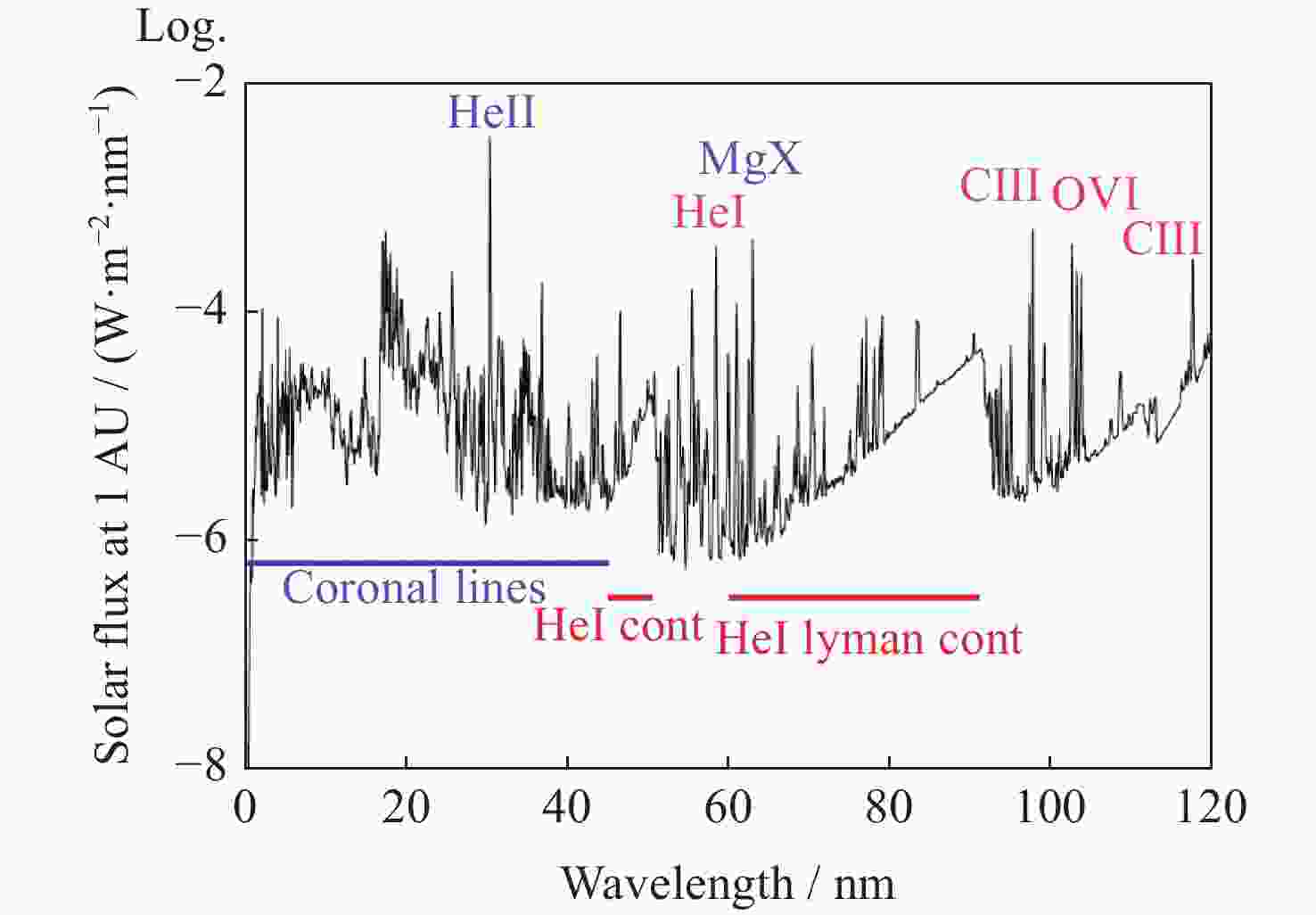
 下载:
下载:

